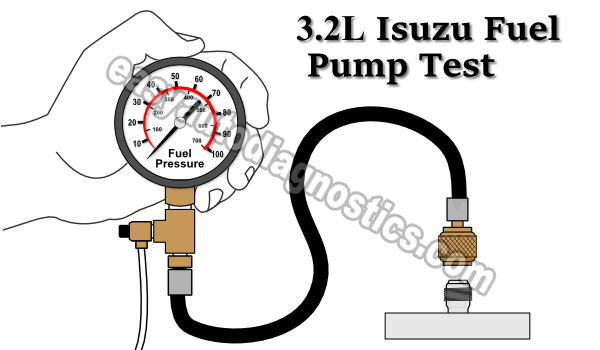1998 Isuzu Rodeo Fuel Pump Wiring Diagram
September 04, 2014 Updated: April 06, 2021 By: Abraham Torres-Arredondo Article ID: 458

Fuel pumps don't last forever and when it fails in your 3.2L Isuzu Rodeo (Amigo or Honda Passport), the engine will crank but not start. If you suspect that the fuel pump is bad and need to find out how to test it, I'll show you how in this tutorial.
With the fuel pump test results you'll get, you'll be able to pinpoint the cause of your no-start problem to a lack of fuel or rule it out and continue with your diagnostic process.
NOTE: This tutorial only applies to the 3.2L Isuzu equipped with a Schrader valve on the fuel injector rail (1998-2004 3.2L Rodeo, 1998-2000 3.2L Amigo, and 1998-2002 3.2L Honda Passport). To identify the location of the Schrader valve, see: Location Of The Schrader Valve.
Symptoms Of A Bad Fuel Pump
Since your Isuzu's engine needs air, fuel and spark to start, when the fuel pump stops working the engine is simply not going to start. You'll see the following symptoms:
- The engine turns over but will not start.
- All six COP ignition coils will spark.
- The PCM will still pulse (activate) all 6 fuel injectors.
What makes testing the fuel pump so easy is that your Isuzu has a Schrader valve to which we can connect a fuel pressure gauge to and see if the fuel pump is actually providing fuel to the fuel injectors.
TEST 1: Using Starting Fluid To Confirm Lack Of Fuel

To get our fuel pump diagnostic under way, the first thing I recommend you do is to check to see if the no-start problem is due to a lack of fuel.
To do this, I use starting fluid. Specifically, I spray starting fluid into the throttle body and have a helper crank the engine. If the engine starts (altho' momentarily), then I know the problem is due to a lack of fuel.
NOTE: To get an accurate test result from the starting fluid test, you need to first confirm that the ignition coils are sparking. You can easily accomplish this by attaching a spark tester to any ignition coil and having a helper crank the engine (while you observe to see if the spark tester sparks).
IMPORTANT: This is a very fast and easy test but you do have to take one very important safety precaution and this is to reconnect the air intake duct after spraying starting fluid down the throttle bore (although you don't have to fasten it). This will prevent any backfire, that might occur, from scaring the heck out of you when cranking the engine.
This is what you have to do:
-
1
Remove the intake air duct from the throttle body. You don't have to completely remove it, since you'll have to reconnect it in one of the next steps.
-
2
Open the throttle plate and spray starting fluid down the bore.
As a safety precaution reconnect the air duct after you have sprayed a good squirt of starting fluid (but you don't have to tighten the air duct's hose clamp).
-
3
Crank the engine once the air duct is back on and you're clear of the engine compartment.
-
4
You'll get one of two results with this test:
1.) The engine will start momentarily and after a few seconds will die or.
2.) The engine will only crank but not start at all.
OK, let's find out what your results mean:
CASE 1: If the engine started and ran for a few seconds: This test result tells you that the no-start problem is due to a lack of fuel.
Your next step is to check to see what the fuel pressure is with a fuel pressure test gauge. Go to: TEST 2: Checking Fuel Pressure With A Fuel Pressure Gauge.
CASE 2: The engine did not start, not even momentarily: This usually means that a lack of fuel IS NOT the reason your car is not starting.
Now, remember what I said about this test not being very accurate? Well, I suggest you do one more test and this is to check the fuel pressure with a fuel pressure test gauge. Go to: TEST 2: Checking Fuel Pressure With A Fuel Pressure Gauge.
Source: https://easyautodiagnostics.com/isuzu/3.2L/how-to-test-the-fuel-pump-1
Posted by: whitedeko0012.blogspot.com